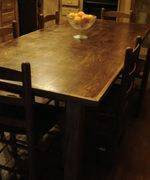


Ikea has become synonymous with new house formations. Students in large numbers and "starters" finding themselves in need of furnishing and pinched for cash opt for the affordable, stylish solution. In the process IKEA has become the world's third largest consumer of wood and though IKEA suggests they are responsible, their consumption patterns are hard to discern. In Ellen Ruppel Shell's new book "Cheap: The High Cost Of Discount Culture" Ikea is taken on as the new WAL-MART.
There is an alternative that may be a little hard to get your mind around at first. A Brit with the fabulous name Nigel Worboy has formed an organization, "Antiques are Green". In the following interview he makes his case for collecting antiques being the oldest form of recycling.
There is a great variance in what constitutes an antique. I don't think one has to learn the trade to begin the process of furnishing your life with sturdy pieces that you can use for a lifetime, pass on, or sell for a profit when you no longer need them. Parents wanting to do their kids a favor might consider off loading to them a piece or two when they need it most. The three pictured items might be good places to begin. The cupboard is named a Hoosier for the company that made them and serves as a kitchen utility area for those short on cabinets. An armoire is a closet that can be moved and comes in many configurations. The farm table could become the multipurpose center of your space. Each of these pieces is guaranteed to appreciate in value and afford you the most bang for the buck in the long run.

Even cheap pieces -- things that are cheaper than that which you'd find at IKEA, e.g. the $70 cupboard on which my television sits -- are made of better materials, which makes them more fun to use, prettier, and sturdier.
ReplyDelete